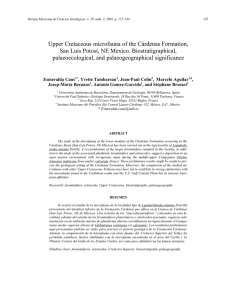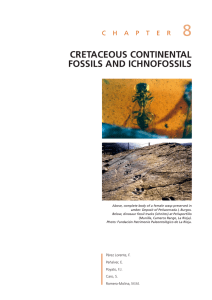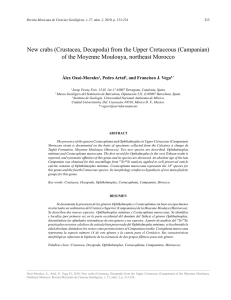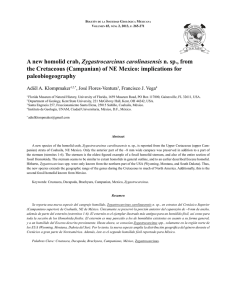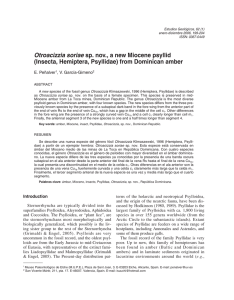A bizarre armoured spider (Araneae: Tetrablemmidae
Anuncio
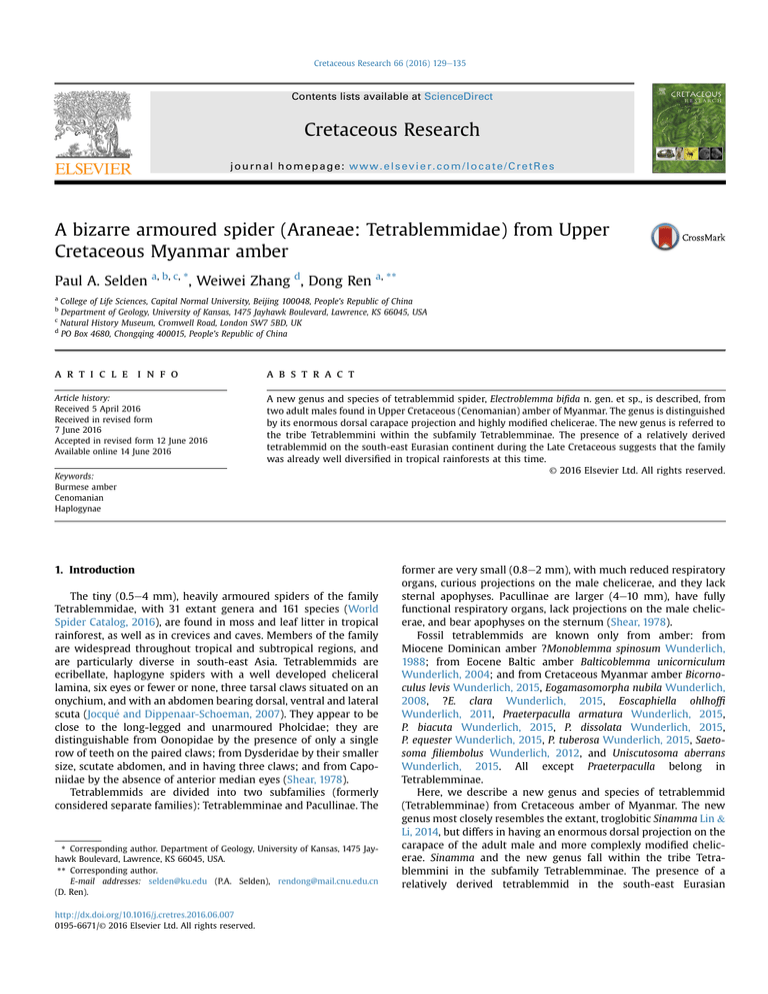
Cretaceous Research 66 (2016) 129e135 Contents lists available at ScienceDirect Cretaceous Research journal homepage: www.elsevier.com/locate/CretRes A bizarre armoured spider (Araneae: Tetrablemmidae) from Upper Cretaceous Myanmar amber Paul A. Selden a, b, c, *, Weiwei Zhang d, Dong Ren a, ** a College of Life Sciences, Capital Normal University, Beijing 100048, People's Republic of China Department of Geology, University of Kansas, 1475 Jayhawk Boulevard, Lawrence, KS 66045, USA c Natural History Museum, Cromwell Road, London SW7 5BD, UK d PO Box 4680, Chongqing 400015, People's Republic of China b a r t i c l e i n f o a b s t r a c t Article history: Received 5 April 2016 Received in revised form 7 June 2016 Accepted in revised form 12 June 2016 Available online 14 June 2016 A new genus and species of tetrablemmid spider, Electroblemma bifida n. gen. et sp., is described, from two adult males found in Upper Cretaceous (Cenomanian) amber of Myanmar. The genus is distinguished by its enormous dorsal carapace projection and highly modified chelicerae. The new genus is referred to the tribe Tetrablemmini within the subfamily Tetrablemminae. The presence of a relatively derived tetrablemmid on the south-east Eurasian continent during the Late Cretaceous suggests that the family was already well diversified in tropical rainforests at this time. © 2016 Elsevier Ltd. All rights reserved. Keywords: Burmese amber Cenomanian Haplogynae 1. Introduction The tiny (0.5e4 mm), heavily armoured spiders of the family Tetrablemmidae, with 31 extant genera and 161 species (World Spider Catalog, 2016), are found in moss and leaf litter in tropical rainforest, as well as in crevices and caves. Members of the family are widespread throughout tropical and subtropical regions, and are particularly diverse in south-east Asia. Tetrablemmids are ecribellate, haplogyne spiders with a well developed cheliceral lamina, six eyes or fewer or none, three tarsal claws situated on an onychium, and with an abdomen bearing dorsal, ventral and lateral and Dippenaar-Schoeman, 2007). They appear to be scuta (Jocque close to the long-legged and unarmoured Pholcidae; they are distinguishable from Oonopidae by the presence of only a single row of teeth on the paired claws; from Dysderidae by their smaller size, scutate abdomen, and in having three claws; and from Caponiidae by the absence of anterior median eyes (Shear, 1978). Tetrablemmids are divided into two subfamilies (formerly considered separate families): Tetrablemminae and Pacullinae. The * Corresponding author. Department of Geology, University of Kansas, 1475 Jayhawk Boulevard, Lawrence, KS 66045, USA. ** Corresponding author. E-mail addresses: [email protected] (P.A. Selden), [email protected] (D. Ren). http://dx.doi.org/10.1016/j.cretres.2016.06.007 0195-6671/© 2016 Elsevier Ltd. All rights reserved. former are very small (0.8e2 mm), with much reduced respiratory organs, curious projections on the male chelicerae, and they lack sternal apophyses. Pacullinae are larger (4e10 mm), have fully functional respiratory organs, lack projections on the male chelicerae, and bear apophyses on the sternum (Shear, 1978). Fossil tetrablemmids are known only from amber: from Miocene Dominican amber ?Monoblemma spinosum Wunderlich, 1988; from Eocene Baltic amber Balticoblemma unicorniculum Wunderlich, 2004; and from Cretaceous Myanmar amber Bicornoculus levis Wunderlich, 2015, Eogamasomorpha nubila Wunderlich, 2008, ?E. clara Wunderlich, 2015, Eoscaphiella ohlhoffi Wunderlich, 2011, Praeterpaculla armatura Wunderlich, 2015, P. biacuta Wunderlich, 2015, P. dissolata Wunderlich, 2015, P. equester Wunderlich, 2015, P. tuberosa Wunderlich, 2015, Saetosoma filiembolus Wunderlich, 2012, and Uniscutosoma aberrans Wunderlich, 2015. All except Praeterpaculla belong in Tetrablemminae. Here, we describe a new genus and species of tetrablemmid (Tetrablemminae) from Cretaceous amber of Myanmar. The new genus most closely resembles the extant, troglobitic Sinamma Lin & Li, 2014, but differs in having an enormous dorsal projection on the carapace of the adult male and more complexly modified chelicerae. Sinamma and the new genus fall within the tribe Tetrablemmini in the subfamily Tetrablemminae. The presence of a relatively derived tetrablemmid in the south-east Eurasian 130 P.A. Selden et al. / Cretaceous Research 66 (2016) 129e135 continent during the Late Cretaceous, together with other tetrablemmids known from the Burmese fauna, implies that the family was already well diversified in tropical rainforests at this time. 2. Material and methods The specimens occur in Myanmar amber (burmite), which comes from Kachin (Hukawng Valley) of northern Myanmar, approximately 10 km south-west of the village of Tanai (Cruickshank and Ko, 2003). Once thought to be of Eocene age, it was later realized, based on palynology and ammonoids and insects preserved in the amber, that burmite is later Albian to Cenomanian in age. Considering other factors (e.g. the near-shore marine environment, the burmite-bearing sediments and volcanic clasts), later workers established an age of earliest Cenomanian (98.79 ± 0.62 Ma) for the deposit (Cruickshank and Ko, 2003; Shi et al., 2012). A summary of the geological setting can be found in Ross et al. (2010, and references therein). The specimens, currently housed in the Key Lab of Insect Evolution and Environmental Changes at the College of Life Sciences, Capital Normal University, Beijing (CNU), will eventually be deposited in the Three Gorges Entomological Museum, Chongqing (specimens available for study by contacting DR or WZ). The specimens are preserved in cut cabochons of amber; BU001725 is in a piece measuring approximately 19 mm 6 mm cut from the centre of a cabochon, and BU-001505 is in a half cabochon measuring approximately 10 mm 5 mm. In the amber are various fragments of organic detritus, and bubbles clinging to the specimens which obscure some of the morphology. Because of the obscuring bubbles and debris, in order to get a complete view of the animals, they were observed, drawn, and photographed (as necessary) from different angles and with different lighting. The specimens were studied and photographed using Leica M165C and M205C stereomicroscopes with Canon EOS 5D MkII and MkIII cameras attached. Photographs were captured using DSLR Assistant software (www.kaasoft.com) on an Apple MacBook Pro computer. Photographs were taken under incident and/or transmitted illumination, as appropriate. Sharper focus was achieved by merging a stack of images using Photoshop CC (see Selden, 2014 for details). Final drawings were made from the photographs and pencil drawings (made with a camera lucida attachment to the M205C microscope) with Autodesk Graphic (www.graphic.com). Note that, due to the three-dimensional nature of amber-preserved specimens, appendage measurements are difficult to obtain because podomeres may lie at an angle to the viewer. Hence, contrary to the usual practice for compression fossils in which measurements of left and right appendages are averaged, the larger of these two measurements, and of both specimens, is recorded. Even so, measurements of appendages must be considered as approximate. Lengths and widths of body, carapace, and opisthosoma are from BU-001725 which is less distorted than BU-001055 (see below). All measurements are in mm. Morphological terms follow Shear (1978). Abbreviations: I, II, III, IV, leg numbers; a pl, anal plate; b, bulb; b l, book lung; cx, coxa; d pl, dorsal plate; em, embolus; fe, femur; L, length; lb, labium; l pls, lateral plates; mt, metatarsus; p, pedicel; p pl, pulmonary plate; pa, patella; pa pl, preanal plate; Pd, pedipalp; pg pl, postgenital plate; st, sternum; ta, tarsus; ti, tibia; tr, trochanter; W, width. 3. Morphological interpretation The two specimens differ somewhat, in that the dorsal carapace projection is pointed posteriorly in BU-001725, with its tip nearly touching the opisthosoma, whereas in BU-001055 the projection is upright. This difference can be explained by specimen BU-001725 appearing to be generally more wrinkled and deflated (presumably dehydrated), thus causing some distortion. Apart from this difference in appearance of the projection, the other effect of the preservation is to foreshorten the appearance of the carapace in dorsal view in BU-001055; thus, body measurements are given for BU-001725. In other tetrablemmid males which bear a dorsal projection on the carapace (e.g. Sinamma Lin & Li, 2014), the eyes are situated on the projection. Therefore, we surmise that our fossil had its eyes situated there as well, but preservation is too poor in this region to see them. No eyes can be seen elsewhere on the carapace. Because of distortion of the specimens, the more sclerotized parts, such as the opisthosomal plates, are generally intact, while less sclerotized organs, such as the pedipalp bulb, have lost there life shapes. It is likely that the bulb was generally bulbous in life, but now appears somewhat rectangular. 4. Systematic palaeontology Family Tetrablemmidae O. Pickard-Cambridge, 1873 Subfamily Tetrablemminae O. Pickard-Cambridge, 1873 Genus Electroblemma n. gen. (LSID urn:lsid:zoobank.org:act:E2B29129-678A-4118-A3C41D1D0D0DE041) Type species: Electroblemma bifida n. sp. Derivation of name. From Greek elektron, amber, referring to the matrix in which the fossils occur; and blemma, appearance, a common suffix for tetrablemmid spiders. Diagnosis. The adult male of this genus differs from others in the Tetrablemminae by: the very long dorsal projection on the carapace, with a bifid tip and likely bearing eyes; the complex anterior horn, with a bifid tip, on the chelicerae; and modifications to the first leg in the form of paired thorns on the distal tibia and a proximally directed thorn on the proximal metatarsus. Electroblemma bifida n. sp. (Figs. 1e3) (LSID urn:lsid:zoobank.org:act:0FD4F7F5-D462-4826-9B9ADF3017F8044A) Derivation of name. From Latin bi-, doubly, and fida, from findere, to split, referring to the carapace projection with its bifid tip. Diagnosis. As for the genus. Type series. Holotype BU-001055, adult male; Paratype BU-001725, adult male, currently housed in the Key Lab of Insect Evolution and Environmental Changes at the College of Life Sciences, Capital Normal University, Beijing (CNU); they will eventually be deposited in the Three Gorges Entomological Museum, Chongqing (specimens available for study by contacting DR or WZ). Type locality. Kachin, Hukawng Valley, Myanmar. Stratigraphic horizon. Upper Cretaceous (lowermost Cenomanian). 4.1. Description Body L (front of carapace to tip of spinnerets) 1.58. Cuticular sculpture generally rugose; pitted on dorsal opisthosoma; somewhat wrinkled on anterior part of carapace and adjacent to base of dorsal projection; pustulose on sternum, ventral opisthosomal plates, and proximal podomeres; body and legs setose; setae large, curved on legs, lacking macrosetae. Carapace L 0.70, W 0.30 (L/W ratio 2.30), elongate suboval in outline but constricted somewhat c. 1 /3 of length from anterior, with slightly converging lateral sides towards straight anterior border. Dorsally, an enormous projection P.A. Selden et al. / Cretaceous Research 66 (2016) 129e135 (L 0.40) arising from approximately mid-length of carapace, directed upwards, narrowing upwards to a subrectangular distal inflation (probably bearing eyes) with pair of small horns at distal tip (Figs. 1A, B, 2C, D, 3A, B). Sternum L 0.39, W 0.30 (L/W ratio 1.29), scalloped laterally with protrusions between coxae. Labium subsemicircular in outline, wider than long, L 0.07, W 0.10 (L/W ratio 0.65). Chelicera L (inc. horn) 0.33; fang basal; proximal part of 131 chelicera subrectangular, bearing curved spine directed ventrally; horn projecting beyond proximal part, narrowing distally, with prolateral projection and bifid tip (Fig. 2A, D). Pedipalp podomere lengths: cx 0.08, fe 0.25, pa 0.10, ti 0.21, ta (exc. bulb and embolus) 0.11, bulb and embolus 0.31; tibia expanded, subovoid; tarsus (cymbium) short, bearing long macrosetae dorsally; bulb large, with long, scimitar-like embolus (Figs. 1C, D, 2A, 3C, D). Fig. 1. Electroblemma bifida n. gen. et sp. from Upper Cretaceous Myanmar amber. Holotype BU-001055. A, dorsal view, see Fig. 1B for explanation; B, explanatory drawing, dorsal view, dark gray areas are bubbles; C, ventral view, see Fig. 1D for explanation; D, explanatory drawing, ventral view. Scale bars represent 0.5 mm. 132 P.A. Selden et al. / Cretaceous Research 66 (2016) 129e135 Fig. 2. Electroblemma bifida n. gen. et sp. from Upper Cretaceous Myanmar amber. Holotype BU-001055. A, ventral view of anterior, showing chelicerae, pedipalps and leg I, see Figs. 1D, 2D for explanatory drawings; B, ventral view of opisthosoma, see Fig. 1D for explanatory drawing; C, detail of carapace horn with subrectangular distal inflation with pair of small horns at distal tip, possibly bearing eyes; D, diagram of taxonomically important features of prosoma, viewed from left dorsolateral aspect: carapace with dorsal projection likely bearing eyes (light gray), chelicerae with bifid anterior horn (medium gray), leg I with paired thorns on tibia and proximally directed thorn on metatarsus (dark gray), (pedipalp in white). Leg formula 4213; legs not greatly different in length. Leg I cx 0.15, fe 0.59, pa 0.17, ti 0.44, mt 0.22, ta 0.20, total (feeta) 1.58; femur slightly sinuous, tibia bearing pair of thorns on prolateral and retrolateral surfaces c. 0.75 from proximal end, metatarsus bearing proximally directed thorn on prolateral surface c. 0.3 from proximal end (Figs. 1C, D, 2A, 3C, D). Leg II cx 0.15, fe 0.55, pa 0.17, ti 0.39, mt 0.35, ta 0.30, total (feeta) 1.68. Leg III cx 0.15, fe 0.45, pa 0.15, ti 0.28, mt 0.31, ta 0.23, total (feeta) 1.43. Leg IV cx 0.15, fe 0.49, pa 0.12, ti 0.51, mt 0.44, ta 0.28, total (feeta) 1.81. Opisthosoma L (inc. spinnerets) 0.93, W 0.52 (ratio 1.79), suboval in outline, bearing dorsal plate, three lateral plates on each side, ventrally an anterior pulmonary plate (L 0.39, W 0.40, L/W ratio 0.98), followed by postgenital plate (L 0.08, W 0.31, L/W ratio 0.26), preanal plate (L 0.23, W 0.28, L/W ratio 0.82), and anal plate (L 0.13, W 0.15, L/W ratio 0.87) forming ring around spinnerets and anal tubercle (Fig. 2B). Female unknown. 5. Discussion Shear (1978) divided the Tetrablemmidae (at that time considered sister family to Pacullidae) into two subfamilies: Brignoliellinae and Tertablemminae. Lehtinen (1981) recognized Pacullinae and Tetrablemminae as subfamilies of Tetrablemmidae, and divided the subfamily Tetrablemminae into five tribes: Ablemmini, Brignoliellini, Fallablemmini, Mattini, and Tetrablemmini on a variety of characters, including eye patterns, male pedipalp bulb shape, and female internal vulval plate shape. Both Shear (1978) and Lehtinen (1981) provided cladograms of their hypotheses, but only recently have Tong and Li (2008) attempted a phylogenetic study of the family using parsimony. Their cladogram had low bootstrap support, but did reveal Tetrablemminae to be a monophyletic subfamily, and their clades corresponded quite closely to Lehtinen's five tribes. However, while Lehtinen had Fallablemmini as his most plesiomorphic clade, Tong and Li (2008) recovered it as P.A. Selden et al. / Cretaceous Research 66 (2016) 129e135 133 Fig. 3. Electroblemma bifida n. gen. et sp. from Upper Cretaceous Myanmar amber. Paratype BU-001725. A, dorsolateral view, see Fig. 3B for explanation; B, explanatory drawing, dorsolateral view; C, ventral view, see Fig. 3D for explanation; D, explanatory drawing, ventral view. Scale bars represent 0.5 mm. 134 P.A. Selden et al. / Cretaceous Research 66 (2016) 129e135 sister to Mattini as the two most derived clades, albeit based on few characters. Their cladogram can be summarized here (using Lehtinen's (1981) tribes): (Brignoliellini (Bacilemma (Ablemmini (Tetrablemmini (Fallablemmini, Mattini))))). The new genus Electroblemma is referred to the family Tetrablemmidae on the basis of the characteristic armoured opisthosoma and the male modifications of the carapace and chelicerae. Its small size, the opisthosomal plate pattern, and the male modifications place the new genus firmly within the subfamily Tetrablemminae (see Shear (1978) and Lehtinen (1981) for additional characters separating these subfamilies). Within this subfamily, the new genus shows most affinity with the Tetrablemmini. Characters that can be seen in the fossil which are consistent with this tribe, as proposed by Lehtinen (1981), include: ocular area modified in males, male chelicerae modified, plates with a reticulate ornament, and modified tibia and metatarsus in male leg I. Electroblemma is closest to the modern genus Sinamma, described recently from caves in south-west China (Guangxi, Hainan) (Lin and Li, 2014). Similarities between the genera are that both bear a long, dorsal, carapace projection, a large cheliceral horn, and modified first legs. However, in Sinamma, the carapace rises more gently towards the projection, which is more akin to a large thorn (Lin and Li, 2014, fig. 1G, E), whereas in Electroblemma the carapace is rather flatter and the projection rises quite dramatically from its dorsal surface and bears a distal inflation (Fig. 2D). Eyes are situated at the base of the projection in Sinamma and, while no eyes can be seen in the fossil, they are assumed to be at the top of the projection. The cheliceral horn in Sinamma, though large, lacks the bifid tip, and the chelicera does not show an additional prolateral extension, seen in the fossil. The first leg in Sinamma males shows an inflated tibia bearing a pair of projections (prolateral and retrolateral at the same distance from the base), and a proximally directed projection near the base of the metatarsus (Lin and Li, 2014, fig. 2C, D, E). These leg I modifications are remarkably similar to those of Electroblemma except that the metatarsal projection appears to be on the prolateral surface in the fossil genus. The shapes of the labium, sternum, and ventral opisthosomal plates are very similar in both genera. In the pedipalp, the embolus shows a sharper distinction from the bulb in Electroblemma than in Sinamma. Lin and Li (2014) compared their new genus Sinamma to Shearella Lehtinen, 1981 and Gunasekara Lehtinen, 1981, which show similar cheliceral horns, pyriform bulb, and modified leg I in the males, and separated these genera on other characters. As an example of the similarity, Shearella sanya Lin & Li, 2010 was assigned to Shearella by Lin & Li (2010), then transferred to Sinamma by Lin & Li (2014), but returned to Shearella by Sankaran & Sebastian (2016). Electroblemma appears to lie somewhere among these genera, of which at least Gunasekara and Shearella form a small clade together with Mariblemma Lehtinen, 1981 in the analysis of Tong and Li (2008). Members of this clade were originally described from Indian Ocean islands, but Shearella and Sinamma are now known from India and China. Thus, the fossil genus lies within a fairly derived clade (Tetrablemmini; possibly within the clade of that tribe including Gunasekara and Shearella) within the Tetrablemminae. Electroblemma differs from the other Burmese amber tetrablemmines by its characteristic carapace projection, which is absent from the described genera. All the tetrablemmids named by Wunderlich (2008, 2011, 2015) are described from adult males; he has recognized females in the Burmese amber material, but not related them to the males. The present authors have in their possession two more adult male tetrablemmids, too poorly preserved for identification but not congeneric with Electroblemma. Clearly, this family was common and diverse in the Cretaceous amber forest of Myanmar. The similarity to the modern Chinese cave genus Sinamma does not imply that Electroblemma was also troglobitic. Many tetrablemmids live on or under bark (especially Tetrablemmini: Lehtinen, 1981), which is where they are most likely to be engulfed in flowing tree resin, rather than in a cave. Tetrablemmid webs are not well known, but those which have been described are small sheets among leaf litter (Tetrablemminae: Lehtinen, 1981; Burger et al., 2006) or in crevices in rocks, beneath stones or on earth banks (Pacullinae: Schwendinger, 1989, 2013). Presumably, crevices in bark would also be acceptable. However, it is most likely that the adult males described here would have been out and about searching for females, rather than confined to a web, when they were engulfed in the resin. The Myanmar amber locality lies within the West Burma terrane (Broly et al., 2015), which was considered to have rifted off from northwest Australia in the Late Jurassic (156 Ma) and drifted northwards, finally colliding with the Eurasian marginal Sibumasu terrane at around 80 Ma (Heine and Müller, 2005; Seton et al., 2012). If this scenario is correct, then the amber forest bearing the biota, including the tetrablemmid, was living on an island at the time (99 Ma) which had separated from Australia some 75 million years earlier. However, more recent ideas of Metcalfe (2013), based on data from Oo et al. (2002), suggested that the West Burma terrane formed part of a continent which separated from Australia in the Devonian as the Paleo-Tethys Ocean opened, and had collided with Eurasia (including the North and South China blocks) by Jurassic times. In the latter scenario, it could be argued that tetrablemmids and their ancestors can be traced back to the Devonian period. However, the oldest known spider comes from the Carboniferous (early Pennsylvanian, 315 Ma) of Russia (Selden et al., 2014), and the oldest araneomorph spiders are known from the Triassic of South Africa and Virginia (Selden et al., 1999); i.e. nowhere near the position of the West Burma terrane. Therefore, an alternative suggestion is that tetrablemmids may have spread onto the docking terrane from Eurasia sometime between Jurassic and mid-Cretaceous times. 6. Conclusions The new genus and species of tetrablemmid spider, Electroblemma bifida n. gen. et sp., from Upper Cretaceous (Cenomanian) amber of Myanmar is distinguished by its enormous dorsal carapace projection and highly modified chelicerae. These features distinguish it from extant relatives such as Sinamma Lin & Li, 2014 and other members of the Tetrablemmini tribe of Tetrablemminae. This tribe consists of relatively derived members of Tetrablemmidae, found in south-east Asia today. The most likely palaeobiogeographic scenario is that tetrablemmids invaded the West Burma terrane after it docked with south-east Eurasia in the Jurassic and diversified in the tropical forests of Cretaceous times. Acknowledgments PAS thanks Zhipeng Zhao, Xiaodan Lin and Chongchuang Deng (CNU, Beijing) for accompanying him to Chongqing to visit WZ, in whose collection the specimen was discovered. We are grateful to David Penney, an anonymous reviewer, and the editor for their helpful comments. This research is supported by the National Basic Research Program of China (973 Program) (2012CB821906), the National Natural Science Foundation of China (No. 31230065), and Program for Changjiang Scholars and Innovative Research Team in University (IRT13081). P.A. Selden et al. / Cretaceous Research 66 (2016) 129e135 References Broly, P., Maillet, S., Ross, A.J., 2015. The first terrestrial isopod (Crustacea: Isopoda: Oniscidea) from Cretaceous Burmese amber of Myanmar. Cretaceous Research 55, 220e228. Burger, M., Jacob, A., Kropf, C., 2006. Copulatory behavior and web of Indicoblemma lannaianum from Thailand (Arachnida, Araneae, Tetrablemmidae). Journal of Arachnology 34, 176e185. Cruickshank, R.D., Ko, K., 2003. Geology of an amber locality in the Hukawng Valley, northern Myanmar. Journal of Asian Earth Sciences 21, 441e455. Heine, C., Müller, R., 2005. Late Jurassic rifting along the Australian North West Shelf: margin geometry and spreading ridge configuration. Australian Journal of Earth Sciences 52, 27e39. , R., Dippenaar-Schoeman, A.S., 2007. Spider Families of the World. Royal Jocque Museum for Central Africa, Tervuren. Lehtinen, P.T., 1981. Spiders of the oriental-Australian region. III. Tetrablemmidae, with a world revision. Acta Zoologica Fennica 162, 1e151. Lin, Y., Li, S., 2010. New armored spiders of the family Tetrablemmidae from China. Zootaxa 2440, 18e32. Lin, Y., Li, S., 2014. New cave-dwelling armored spiders (Araneae, Tetrablemmidae) from Southwest China. ZooKeys 288, 35e67. Metcalfe, I., 2013. Gondwana dispersion and Asian accretion: tectonic and palaeogeographic evolution of eastern Tethys. Journal of Asian Earth Sciences 66, 1e33. Oo, T., Hlaing, T., Htay, N., 2002. Permian of Myanmar. Journal of Asian Earth Sciences 20, 683e689. Pickard-Cambridge, O., 1873. On some new genera and species of Araneidea. Proceedings of the Zoological Society of London 1873, 112e129. Ross, A., Mellish, C., York, P., Crighton, B., 2010. Burmese amber. In: Penney, D. (Ed.), Biodiversity of Fossils in Amber from the Major World Deposits. Siri Scientific Press, Manchester, pp. 208e235. Sankaran, P.M., Sebastian, P.A., 2016. A checklist of Indian armored spiders (Araneae, Tetrablemmidae) with the description of a new species from the Western Ghats. Zootaxa 4084, 443e450. Schwendinger, P.J., 1989. On three new armoured spiders (Araneae: Tetrablemmidae, Pacullinae) from Indonesia and Thailand. Revue Suisse de Zoologie 96, 571e582. Schwendinger, P.J., 2013. A taxonomic revision of the spider genus Perania Thorell, 1890 (Araneae: Tetrablemmidae: Pacullinae) with the descriptions of eight new species. Revue Suisse de Zoologie 120, 585e663. 135 Selden, P.A., 2014. A workflow for digital photography of fossil specimens. The Geological Curator 10, 93e98. Selden, P.A., Anderson, J.M., Anderson, H.M., Fraser, N.C., 1999. Fossil araneomorph spiders from the Triassic of South Africa and Virginia. Journal of Arachnology 27, 401e414. Selden, P.A., Shcherbakov, D.E., Dunlop, J.A., Eskov, K.Y., 2014. Arachnids from the Carboniferous of Russia and Ukraine, and the Permian of Kazakhstan. Pal€ aontologische Zeitschrift 88, 297e307. Seton, M., Müller, R.D., Zahirovic, S., Gaina, C., Torsvik, T., Shephard, G., Talsma, A., Gurnis, M., Turner, M., Maus, S., Chandler, M., 2012. Global continental and ocean basin reconstructions since 200Ma. Earth Science Reviews 113, 212e270. Shear, W.A., 1978. Taxonomic notes on the armored spiders of the families Tetrablemmidae and Pacullidae. American Museum Novitates 2650, 1e46. Shi, G., Grimaldi, D.A., Harlow, G.E., Wang, J., Wang, J., Yang, M., Lei, W., Li, Q., Li, X., 2012. Age constraint on Burmese amber based on UePb dating of zircons. Cretaceous Research 37, 155e163. Tong, Y., Li, S., 2008. Tetrablemmidae (Arachnida, Araneae), a spider family newly recorded from China. Organisms Diversity & Evolution 8, 84e98. World Spider Catalog, 2016. World Spider Catalog, Version 17.0. Natural History Museum, Bern online at. http://wsc.nmbe.ch. €ge Wunderlich, J., 1988. Die fossilen Spinnen im dominikanischen Bernstein. Beitra zur Araneologie 2, 1e378. Wunderlich, J., 2004. Fossil spiders (Araneae) of the superfamily Dysderoidea in Baltic and Dominican amber, with revised family diagnoses. Beitr€ age zur Araneologie 3, 633e746. Wunderlich, J., 2008. The dominance of ancient spider families of the Araneae: haplogyne in the Cretaceous, and the late diversification of advanced ecribellate spiders of the Entelegynae after the CretaceouseTertiary boundary €ge zur Araneologie extinction events, with descriptions of new families. Beitra 5, 524e675. €ge Wunderlich, J., 2011. Some fossil spiders (Araneae) in Cretaceous ambers. Beitra zur Araneologie 6, 539e557. Wunderlich, J., 2012. On the fossil spider (Araneae) fauna in Cretaceous ambers, with descriptions of new taxa from Burmese (Burma) and Jordan, and on the €ge zur Araneologie 7, relationships of the superfamily Leptonetoidea. Beitra 157e232. Wunderlich, J., 2015. On the evolution and the classification of spiders, the Mesozoic spider faunas, and descriptions of new Cretaceous taxa mainly in amber from Burmese (Burma) (Arachnida: Araneae). Beitr€ age zur Araneologie 9, 21e408.
